Anything but subtle | 2017 Lamborghini Aventador S First Drive
It’s just past dawn and I’m running on a thin supply of caffeine and adrenaline, but the 2017 Lamborghini Aventador S I’m chasing around Circuit Ricardo Tormo just made me crack a grin: faint blue flames are simmering deep within the leader’s three exhaust pipes, pulsing almost imperceptibly as it whips around the track.
Few things about the Lamborghini Aventador LP700-4 (including its alphanumeric name) were subtle, but the boys in Sant’Agata Bolognese have gone full-bore at refining the famously unwieldy flagship enough to make it drive as capably as it looks. This updated version has been rechristened with an S at the end of its name, and yes, in the twisted microcosm of earthbound fighter jets, flames coming out of hindquarters qualify as subtle. Of course the Aventador S produces more power – to the tune of 729 horsepower, a 38-hp climb from before, with torque only increasing by one, to 509 pound-feet – and the extra grunt affects neither its 0-to-62-mph time of 2.9 seconds nor its terminal velocity of 217 mph. But version 2.0’s most notable improvements apply to the big Lamborghini’s chassis, which now uses a four-wheel-steering system to countersteer the rear wheels below around 75 mph, and turn them in phase with the fronts for stability at higher speeds. The system responds in 5 milliseconds, and has the virtual effect of shortening the wheelbase by up to 20 inches or lengthening it by 27 inches. In case you’re keeping tabs, the extra 13 pounds of the steering hardware are offset by a new titanium exhaust system, essentially rendering the curb weight unchanged.
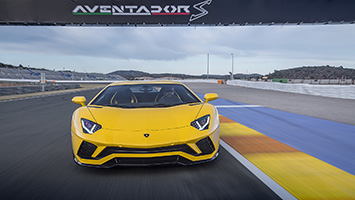
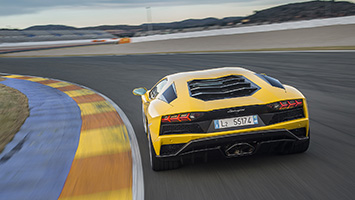

If you’ve ever tried to toss a boomerang through a maze, you’ve got a basic idea of what it took to carry an original Aventador through a high-speed corner. The act required some patience to allow the front wheels to dig in and take hold, and even more resolve to wait for the perfect moment to squeeze the right pedal and power out of the apex. Accelerate too early, and you’d suffer terminal understeer until you allowed the weight to shift, likely triggering traction control as you goosed the throttle on the way out. At the Spanish track, the new Aventador manages something the first one couldn’t: though it still retains some understeer, it also dances and turns more willingly, snaking its way through each corner with a gratifying combination of weight transfer and grip. Oh happy, fire-breathing day.
There’s more than four-wheel steering at play helping the Aventador S grapple with the corners. On top of revised suspension kinematics and geometry as well as new upper and lower arms and wheel carriers, the pushrod suspension now uses adaptive magnetorheological shocks like those on the Aventador SV. The stability control and Haldex all-wheel-drive systems have been revised so power doesn’t dump to the front wheels during off-throttle maneuvers, making it easier to steer the beast with the right pedal and power out of corners. Revised aerodynamics boost downforce and decrease drag, depending on the three-setting spoiler’s position. The new EGO system offers customizable drive modes, separating steering, suspension, and drivetrain settings for a total of 24 combinations. Last, and certainly not least, the notoriously herky-jerky seven-speed automated manual gearbox has been re-tuned for (slightly) more smoothness.
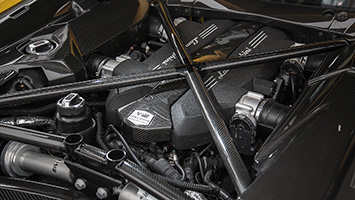
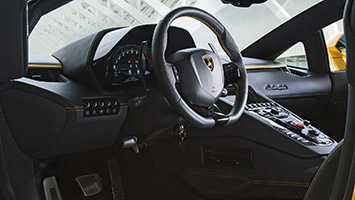
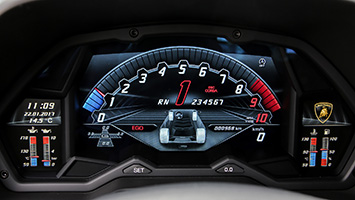
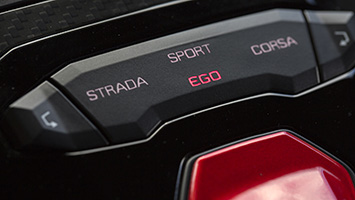
To highlight the improvements, Lamborghini provided a back-to-back slalom drive between an Aventador LP700-4 and the new S model. The sum of the changes are dramatic: where the old model feels bulky and reluctant to turn, the new one seems hinged at the middle, negotiating surefootedly through the tight course of pylons. The Aventador S feels smaller, nimbler, and livelier, its four-wheel-steer system responding imperceptibly to driver inputs.
After the slalom exercise, I return to the 2.5-mile circuit determined to push the supercar harder. Though new rainfall begs for caution, the screaming V12 tickles the devil on my shoulder and against the advice of event organizers (kids, don’t try this at home), I switch off the electronic aids. As expected, with my right foot acting as traction control, the combination of a relatively light flywheel effect, low surface friction, and obscene power makes the Aventador S’s tail snap out of line dramatically when instigated. But unlike the LP700-4, the S feels more composed as it drifts at speed, responding to stabs of the throttle and brake with the appropriate weight transfer and yaw rotation. It may not deliver the ultimate precision or control, but it’s a palpable improvement over the previous car.
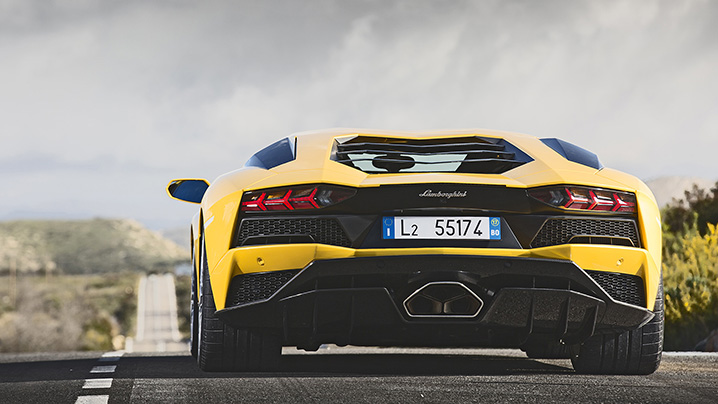
When track time ends without incident, it’s time to drive home on public roads and highways, an act of automotive shock and awe that leaves a trail of incredulity and wonder with the locals. To see an Aventador rumble down Rodeo Drive is one thing, but entirely another when it’s passing through a modest European country that’s unaccustomed to exotics that cost more than a suburban home. Though we don’t come close to exploiting the car’s limits through mountain passes, the Lambo feels more composed and better connected with the tarmac that passes beneath it. The transmission still pauses and lurches, but less abruptly. Engineering changes aside, the Aventador’s human factor is, as before, absolutely off the charts: the low-slung Italian wedge has a way of making women stare, men cheer, and children break out into visible hysterics. It’s the stuff of classic Lamborghini, packing the sort of visual wallop that inspires teens to hang posters on their walls and middle-aged men to deplete their IRAs.
For all of its mechanical excesses, the Lamborghini Aventador S still doesn’t make a whole lot of sense to level-headed high-end car shoppers. If you want a more logical Lambo that happens to be a better driver’s car, consider the Huracán: it’s lighter, more tossable, and considerably better behaved thanks to its seamless dual-clutch and revvy V10. Or better yet, hold out for the Huracán Performante, which should be even swifter than the current (sold out) king of the hill, the Aventador SV.
But, if nothing less than the most dramatic, in-your-face snorting bull will do, there is no replacement for the almighty Aventador S, an unapologetic flagship that easily makes other supercars look commonplace. Though not without its quirks, Lamborghini’s top dog proudly remains the last naturally aspirated, carbon-bodied, mid-engine V12 car in serial production. That automotive peerlessness not only makes it easy to forgive its clear and present flaws, it makes the $421,350 MSRP seem well worth every penny.
Related Video:
